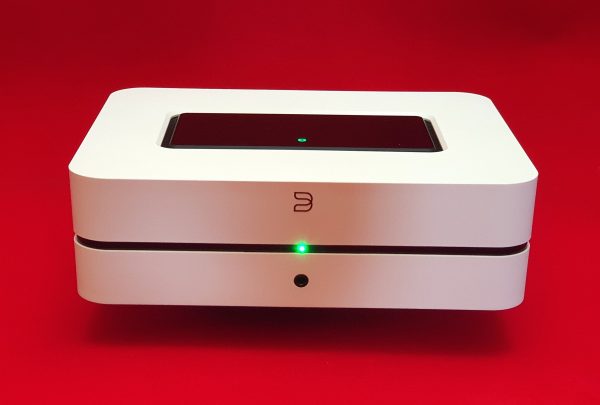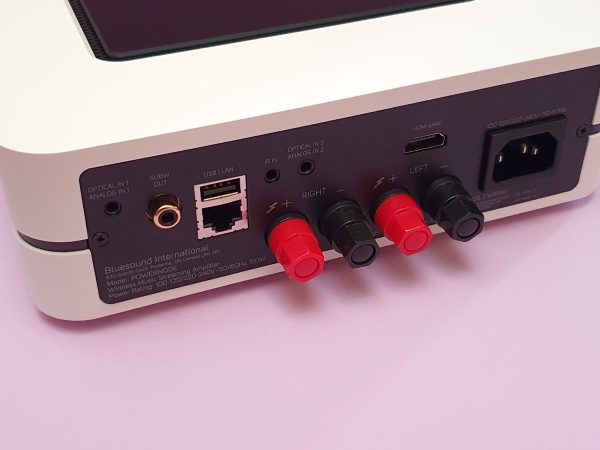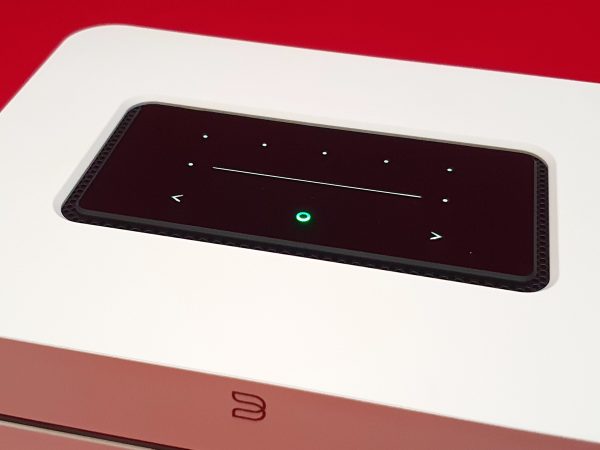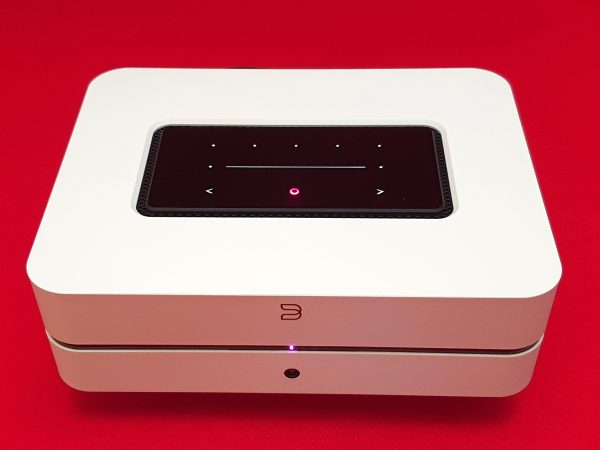BLUESOUND POWERNODE (2021) streaming amplifier
+ Well specified connectivity, wired and wireless; BluOS is a mature and slick app which integrates well with most devices and hi-fi systems and components; new touch panel interface is slick and has useful new functions; operations are smooth and lag-free; new DAC section has significant gains in detail, clarity and transparency, with strengths in rhythm and a spacious soundstage; amplifier will drive most modern speakers well; smooth integration via Spotify Connect and Tidal Connect with its native apps, and Roon Ready integration.
– Not much at the asking price – perhaps a real display on the unit would have been the icing on the cake; no Apple Music integration beyond Airplay2; no DSD support
Sound: 8/10
Value: 9/10
A guide to the ratings
AN ADMISSION – I did this review concurrently with the review of the NODE (2021), so there will be a lot of text which I will lift and drop regarding the functionality and features as they have the same core streaming engine. For a more in depth description of those details and some history of the Bluesound brand, please refer to my previous review.
The POWERNODE (2021) represents the fourth generation of Bluesound’s “just add speakers” super integrated streaming amp offering in its lifestyle hi-fi brand. This category has really fleshed out in recent years, and with many established brands (Naim, Arcam, NAD to mention a few) offering some very attractive models, Bluesound has had to update its offerings to keep in line with the competition.I
In keeping with its differentiated positioning vs its most direct multi-room audio competition, SONOS, Bluesound has focused more on the hi-fi end of the market, with emphasis on components such as the NODE streamer this POWERNODE streaming amp, whilst SONOS has been more focused on the powered speaker and soundbar market, and has not truly entered the high-res market.

Hi-fi aspirations notwithstanding, the lifestyle nature of Bluesound products is still apparent in the design – much more in line with an appliance that you would put in your lounge as part of its design rather than hidden in a hi-fi dungeon. The current POWERNODE does not look very different from its forebears, the Powernode 2 and Powernode 2i. It comes as a smart dense plastic enclosure in Black or White finishes, with rounded corners and a line around the circumference to break up an otherwise plain set of sides. It is almost twice the height of the NODE and 50% larger in top surface area than the NODE. Lifting it shows a little bit of heft and the unit is dense, but it would never be described as heavy per se – no doubt the use of Class D amplification helps with overall weight and size. In use, the unit gets only slightly warm to the touch.
On top, the touch panel has been upgraded with a proximity sensitive set of buttons and sliders. Of particular note are five multi-function touch buttons on top which can be programmed as shortcuts to playlists, radio stations and the such. A volume slider is available as well as skip, play and pause buttons. There is no supplied IR remote control, though one is available for purchase, but the unit can be programmed to understand commands from most existing remote control units you might already have.

Connectivity is very good, especially considering the modest size of the unit – which includes the mains PSU internally, fed by an IEC mains input socket. Inputs are rich – via dual-band WiFi or wired Gigabit Ethernet, the unit can connect to a multitude of streaming services such as Spotify, Tidal, Qobuz and Deezer. In addition, BluOS onboard is Roon Ready and will act as a fully featured endpoint. Airplay 2 support is also on board for iOS devices, though there is no direct integration to Apple Music. BluOS can also connect to SMB shares on your NAS. There is also a USB-A socket which can access portable HDDs connected directly to the unit.
There is also two-way Bluetooth on board, playing out to bluetooth headphones and speakers as well as receiving Bluetooth audio streams from DAPs, tablets and smartphones. It is also fully featured in terms of audio codecs with APT-X, APT-X HD and AAC onboard as well as the obligatory SBC. Physical inputs are doubled on a 3.5mm analogue input, which also is a 3.5mm jack optical Toslink input. A new addition to the POWERNODE (2021) is a HDMI eARC input, de rigueur these days for integration into home AV set-ups.
Physical outputs are one 3.5mm headphone jack on the front and a set of 4mm binding posts for connection to speakers with rated impedance of 4-8Ωs impedance.
Onboard is an upgraded new generation 1.8 GHz quad-core ARM Cortex A53 processor with increased memory and processing power, running BluOS. Also upgraded is a new DAC with the capability to decode 32-bit/382kHz PCM data, though I was unable to confirm if BluOS can pass PCM data in excess of 24/192. The DAC and unit does not handle DSD streams or files, though there is a rather poor workaround in BluOS to play such files though transcoding. The onboard DAC is also a full-fledged MQA renderer and as such works well with Tidal MQA streams as well as MQA files streamed from a NAS or via Roon.

The new version of the POWERNODE’s amplification gets a small bump up in output power to 80W per channel into 8Ω – the new Class D amps are said to be further refined over those in the Powernode 2i.
In terms of app support, BluOS is a very mature ecosystem with elegant apps for both iOS and Android for your mobile devices as well as Windows and MacOS apps for your desktop computers. The interface is easy to use and functionality is quick and intuitive, on par with SONOS’ apps. However, most may find it even easier to stream to the POWERNODE using Spotify Connect or Tidal Connect which will sense the POWERNODE as a speaker to send audio to. Of particular note, Tidal Connect supports MQA streaming from its Masters collection of tracks.
Roon integration has been part of the BluOS ecosystem for years as a Roon Ready endpoint, and a Roon set-up will pick up all the signalling back from the POWERNODE including the processing.
Last but not least, the POWERNODE supports voice assistant integration for Amazon Alexa, Google Home and Apple Siri.
TESTING
I tested the POWERNODE with a number of speakers: Audio Note AN-E speakers, Q Acoustics Concept 500 floorstanders and also KEF LS50s. I also compared it with the Audio Note speakers against a Naim Uniti Atom streaming integrated amplifier.
I tested the analogue input using a Pioneer CDJ 800 Mk2 CD player, and briefly, the optical digital input using a Sony D100 digital field recorder as a monitor for a recording.
I also briefly tested the unit via the eARC input, and also with Grado Hemp headphones on the headphone output and a pair of Bowers and Wilkins PX headphones in Bluetooth mode.
I warmed up the unit prior to listening, but I noticed that it doesn’t require much warm up at all, as it is powered on at all times to be ready to accept network commands.
LISTENING
– with the Q Acoustics Concept 500
I used the same tracks I used for the NODE (2021) review to eke out any differences between the two sister units, and as such it was gratifying to hear a consistency of voicing and general demeanour across the units, amplification notwithstanding.
I started with my CD Rip of Zero 7’s When it Falls (16/44 FLAC CD Rip). The warmth of the upper bass in the recording was rendered well, without too much extra warmth – the amplification is very even handed. Low bass was present and palpable through the floorstanders. More importantly, the multi-layered production was easy to discern with good rhythm and drive. Sia’s vocals were well rendered with a solid image and not masked by excessive bass emphasis.
On Waltz for Debby (24/194 FLAC file from HDTracks), Bill Evans’ trio showed fine form with good swing in rhythms, and a believable projection of the three instruments in the soundstage. Cymbal and brush textures were well rendered with good air and ambiance retrieval from the live recording.

I rounded off the formal listening with maestro Herbert von Karajan conducting Beethoven’s Symphonies leading the Berliner Philharmoniker in 1963 (Tidal MQA stream). The MQA stream was well rendered by the POWERNODE, showing a little more finesse than through a non-MQA system. Soundstage dimensionality was good, with the orchestra placed believably in front of the listener with good depth. Rhythms again were well handled with a good sense of the ebb and flow between the sections of the orchestra.
I listened for many hours more on a variety of material from Tidal as well as from my own library and the POWERNODE provided hours of fatigue free listening, a testament to how easy it is to live with and how addictive the ease of use is to browse and discover music.
– with KEF LS50s
The LS50s often can prove a challenge for some amplifiers – although nominally8Ω, these speakers have very low impedance dips which can prove challenging for some amps to drive. The POWERNODE made no bones of this challenge – it drove the LS50s well and allowed the speakers to shine, with pinpoint imaging and midrange clarity.
I noted that vocals were especially nicely rendered – the midrange shine was good with the LS50s, and Sia’s diction was very easy to pick out from the dense production on Zero 7’s Somersault.
– with Audio Note AN-Es and vs Naim Uniti Atom
The AN-Es presented a different challenge – one not of power or current as these speakers are very efficient, but one of subtlety. These transducers lose very little energy and hence the character of the partnering electronics is more easily heard. I put the POWERNODE up against my own Naim Uniti Atom, which is also a super integrated streaming amplifier.
On the test tracks, the Naim bested the POWERNODE on almost every track, but not by huge margins. The Naim exhibited a clearer sense of urgency and drive coupled with a slightly sweeter top end and a little more cohesion from top to bottom. Of note: on Waltz for Debby, the rhythm and air of Paul Motian’s cymbal and brush work were just that little smoother and thus more enjoyable.
Considering that the Naim is more than twice the price of the POWERNODE, this speaks volumes for how good the POWERNODE is.
– other modes of testing
I tested the analogue input using a Pioneer CDJ 800 MK2 feeding the analogue 3.5mm minijack input. Showing that the analogue input is not an after-thought, there was good transparency to the source CD, in this case an early UK pressing of Sting’s A Brand New Day. The opening track with its subsonic rumbles came though clearly even when digitised and piped over a network.
I also tested the digital input by using the POWERNODE as a monitor for a recording I was making on a Sony D100 field recorder of a rare piece of vinyl for my own archiving purposes. The optical input locked onto the 24/96 recording stream and performed well to allow me to monitor the recording.

Next, I hooked it up briefly to my TV via the eARC input and it worked duly after some configuration, though I would point out that not all TVs have ARC or eARC well implemented so your mileage may vary.
Last but not least, I tested the Bluetooth output to my B&W PX headphones which sport APT-X HD codec which the NODE supports. Connecting was a doddle on the BluOS app and I was able to listen via Bluetooth – the codec exacts a small fidelity penalty, but the convenience far outweighs this.
I also briefly tested the headphone output on the front with a pair of Grado Hemp headphones and it has the same basic hallmarks of the rear analogue outputs, though I would say that the power output is limited, so it will not drive serious headphones such as planar magnetics.
CONCLUSION
Although the POWERNODE and the NODE clearly share very similar internals and engineering, it becomes evident that the target market for each unit is distinct. Whilst the NODE is aimed at those who already have a hi-fi system which may not have streaming capabilities (and it serves in that role admirably), the POWERNODE is aimed at those who are seeking a one-box solution. Although not literally “one box”, the POWERNODE exemplifies a growing niche of super integrated streaming amps to which you need only add speakers (and some cable to attach them, of course). This allows for a true hi-fi system, one that ticks all the audiophile niceties and further facilitated by a choice of speakers to match your taste and your room.
The POWERNODE thus represents a very high value way to get into this future of hi-fi – the streaming platform is mature and slick, and the digital electronics are well thought through with great flexibility and connectivity. The built-in amplification is equally flexible and will likely drive almost any reasonable modern speaker (those with exotics need not apply) to great effect. The new DAC and amplification in the POWERNODE have lifted it to a commendable level and I would recommend it wholeheartedly to any aspiring streaming audiophile as well as established audiophiles looking for a convenient way to set up a second system.
My only wishes would be for DSD support and perhaps some form of Apple Music integration (especially now with Lossless and High Res streaming) beyond the limitations of Airplay 2!
For those looking for more upmarket streaming amplifiers, Bluesound’s sister brand NAD has the M10 (now in v2 guise) and M33. But also there are formidable alternatives from Arcam, Cambridge Audio and Naim which offer excellent variations on the “just add speakers” theme.
As with the NODE, the POWERNODE is highly recommended.
Gear
Sources: Pioneer CDJ 800 MK2, Sony D100, Roon Core running on an Intel NUC i7, Spotify and Tidal / Speakers: Q Acoustics Concept 500, KEF LS50, Audio Note AN-E
Price: US$899
Malaysian price: RM4,499
Review sample courtesy of Lenbrook Asia.






Leave a Reply